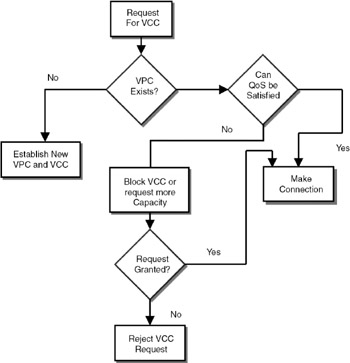29.3 CALL ESTABLISHMENT IN ATM NETWORKS
|
| < Day Day Up > |
|
29.3 CALL ESTABLISHMENT IN ATM NETWORKS
The flow chart for establishment of a call in an ATM is shown in Figure 29.3. To set up a virtual channel, there must be a virtual path connection to the destination node with sufficient available capacity to support the virtual channel, with the required quality of service. Virtual path control mechanisms include calculating routes, allocating capacity, and storing connection state information. Virtual path connection (VPC) is a concatenation of VC links between various switches (for example, the concatenation of link 1 and link 2 in Figure 29.1). Cell integrity is preserved for cells belonging to the same VCC. A unique ID is given to the virtual path and virtual channel. Virtual channel identifier (VCI) is for a particular link in a given VPC. Virtual path identifier (VPI) is the ID for a particular link.

Figure 29.3: ATM call establishment procedure.
A virtual channel connection can be established between end users, between the end user and the switch, or between two switches.
A VCC can be established between end users, between end user and switch, or between two switches.
-
Between end users: to carry user data/control signaling. VPC provides the users with an overall capacity. The set of VCCs should not exceed the VPC capacity.
-
Between end user and switch: for user to network control information.
-
Between two switches: for traffic management and routing functions.
The characteristics of virtual channel are:
-
Quality of service: Quality of service is specified by cell loss ratio (cells lost/ cells transmitted) and cell delay variation.
-
Switched and semipermanent virtual channel connections can be established.
-
Within a VCC, all cells are received in sequence. If the VCC carries voice, then at the destination, it is easy to replay the voice cells because there is no need for rearrangement.
-
Traffic parameters and usage monitoring are negotiated for each VCC. The network continuously monitors the VCC to ensure that negotiated parameters are not violated. The traffic parameters can be average data rate and peak data rate.
In the flow chart given in Figure 29.3, a VCC is established when the QoS parameters can be guaranteed. It may happen that new VCCs are requested when QoS cannot be guaranteed. So, to manage the traffic parameters, strategies need to be worked out.
Within a VCC, all the cells are received in sequence. The quality of service parameters such as cell loss ratio, and cell delay variation will be maintained within a VCC.
The strategies can be:
-
Deny request for new VCCs (the best choice)
-
Discard cells
-
Terminate existing connections (worst)
The characteristics of virtual path connection are
-
To match the desired quality of service.
-
To set up switched and semipermanent virtual path connections.
-
To negotiate traffic parameters and to monitor the usage.
-
To maintain cell sequence.
Note that the characteristics are duplicated in VPC and VCC. The advantages of duplication of characteristics are that the VCC has to function within certain boundary limits and after VPC is set up, new VCCs may be set up. Both these aspects introduce discipline into the network.
| Note | When a desired quality of service cannot be maintained, one of the following strategies is used: (a) deny requests for new VCC, which is the best choice, (b) discard some cells, and (c) terminate the existing connections which is the worst choice. |
|
| < Day Day Up > |
|
EAN: 2147483647
Pages: 313